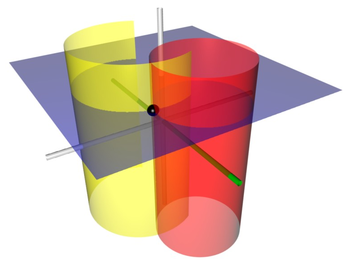
Bipolar cylindrical coordinates are a three-dimensional orthogonal coordinate system that results from projecting the two-dimensional bipolar coordinate system in the perpendicular -direction. The two lines of foci and of the projected Apollonian circles are generally taken to be defined by and , respectively, (and by ) in the Cartesian coordinate system.
The term "bipolar" is often used to describe other curves having two singular points (foci), such as ellipses, hyperbolas, and Cassini ovals. However, the term bipolar coordinates is never used to describe coordinates associated with those curves, e.g., elliptic coordinates.
YouTube Encyclopedic
-
1/5Views:6592 7951 0521 0342 627
-
Project 1 Cylindrical Coordinates Robot
-
NSphereGeometryWall12.wmv
-
Super Junction LDMOS 3D TCAD Simulation
-
Graphene
-
Physics - Advanced E&M: Ch 1 Math Concepts (11 of 55) What is the Divergent of a Vector?
Transcription
Basic definition
The most common definition of bipolar cylindrical coordinates is
where the coordinate of a point equals the angle and the coordinate equals the natural logarithm of the ratio of the distances and to the focal lines
(Recall that the focal lines and are located at and , respectively.)
Surfaces of constant correspond to cylinders of different radii
that all pass through the focal lines and are not concentric. The surfaces of constant are non-intersecting cylinders of different radii
that surround the focal lines but again are not concentric. The focal lines and all these cylinders are parallel to the -axis (the direction of projection). In the plane, the centers of the constant- and constant- cylinders lie on the and axes, respectively.
Scale factors
The scale factors for the bipolar coordinates and are equal
whereas the remaining scale factor . Thus, the infinitesimal volume element equals
and the Laplacian is given by
Other differential operators such as and can be expressed in the coordinates by substituting the scale factors into the general formulae found in orthogonal coordinates.
Applications
The classic applications of bipolar coordinates are in solving partial differential equations, e.g., Laplace's equation or the Helmholtz equation, for which bipolar coordinates allow a separation of variables (in 2D). A typical example would be the electric field surrounding two parallel cylindrical conductors.
Bibliography
- Margenau H, Murphy GM (1956). The Mathematics of Physics and Chemistry. New York: D. van Nostrand. pp. 187–190. LCCN 55010911.
- Korn GA, Korn TM (1961). Mathematical Handbook for Scientists and Engineers. New York: McGraw-Hill. p. 182. LCCN 59014456. ASIN B0000CKZX7.
- Moon P, Spencer DE (1988). "Conical Coordinates (r, θ, λ)". Field Theory Handbook, Including Coordinate Systems, Differential Equations, and Their Solutions (corrected 2nd ed., 3rd print ed.). New York: Springer-Verlag. unknown. ISBN 978-0-387-18430-2.





























